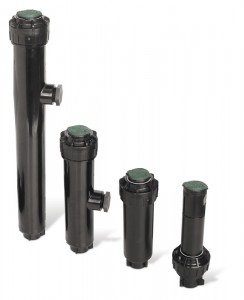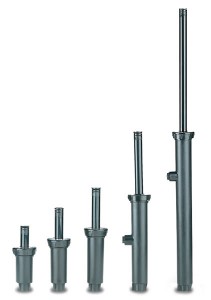 Impact heads are the heads popularly known as rainbirds–at least to people in Utah. These are also the heads that inspired the dance move and several jokes I have heard.
Impact heads are the heads popularly known as rainbirds–at least to people in Utah. These are also the heads that inspired the dance move and several jokes I have heard.
These heads are likewise celebrated by those who understand irrigation as the most efficient heads on the market! If you are going to water a large area then these are the best heads to use…and in the words of Frank Catton (Bernie Mac), “Nuff Said!”
In fact, I would go so far as to say that if you are going to use one of the three heads mentioned to water your Outdoor Living Space or Flower Bed, then you should design that area to have at least 30 foot to 45 foot dimensions so you can use these heads to water. That is what I do.
These heads do have negatives. They do have to be nozzled up like the rotors, so check out the previous post for information on how to do that best.
They also can only be used on larger spaces and operate ideally at 60 p.s.i. So design your spaces to be larger and use a pump if you have to raise your pressure in your system. If is worth it to be able to use these heads.
The last disadvantage of these heads is that they can have lawn or groundcover grow into the casing, causing them to get plugged up and stop working. The answer to this is to make sure to keep the plantings directly around them trimmed back.
In case you hadn’t noticed yet, these are my favorite heads to use when watering with overhead spray heads!
Rotors are a great way to water large areas. Rotors are significantly enough more efficient than spray heads that they should be considered whenever possible.
Rotors are significantly enough more efficient than spray heads that they should be considered whenever possible.
Care should be taken with rotor heads to make sure that you put the proper nozzle in each head so that they are all matched precipitation rates (see the explanation of matched precipitation rates in the spray head post). This takes a little bit of thinking when designing your system for your flower beds or Outdoor Living Spaces.
I will not get into this in too much detail but there are two ways to handle matching the precipitation rates.
The first way to match the precipitation rates is to find the inches per hour for a nozzle and then install the smallest rate in the quarter sprays, approximately two times the quarter rate in the half sprays, and about four times the quarter rate in the full sprays. This will ensure that the water will be applied evenly.
The thing to keep in mind with this method is that the nozzle that you will put in the full head will spray a lot farther and potentially result in a lot of watering concrete, but the efficiency is worth the trade off to me. Design around the shortest distance and deal with the overspray.
The second way to handle matching precipitation rates begins with the design phase. Break up the system so that the quarters and halves are on a valve together and the fulls are on a valve together. You then proceed as mentioned earlier with nozzling the quarters and halves, but the fulls will get either the same nozzle as the quarters or the same nozzle as the halves.
You manage the difference on the clock with the watering duration. If you use the same nozzle as the quarters, you will set that station for four times the run time of the quarters and halves. If you use the same nozzle on the halves and fulls, you set the run time on the full heads for twice that of the other. This is a tricky little way of controlling the efficiency and being able to prevent a lot of overspray. See the Watering Your Landscape in Utah posts for setting your clock.
As far as the disadvantages of these heads, they do have working gears inside them so there is the increased potential of those parts breaking–at least more so than for spray heads.
Also, there are rotor heads that will cover areas down to as small as about fifteen feet, but any smaller and you have to use the spray heads.
Last, these heads operate most efficiently at about 55-60 p.s.i., so they are right out when it comes to low pressure systems without the aid of a pump. Operating at a pressure that is too low will result in cute little green rings around the heads.
 Spray heads, like the ones to the left here, are probably the most common heads used for watering Outdoor Living Spaces. This has become the ultimate tool for those who don’t understand irrigation principles.
Spray heads, like the ones to the left here, are probably the most common heads used for watering Outdoor Living Spaces. This has become the ultimate tool for those who don’t understand irrigation principles.
The biggest advantages of these heads are that they are easy to use efficiently because most of the nozzles you would use on these heads all have matched precipitation rates (MPR). This means that the water is applied evenly across the landscape where they are used.
These heads also work very well for small areas and for places where the water pressure is lower than normal. I always recommend using the heads with the built in PRS (Pressure Regulating System) because they operate most efficiently at 30 p.s.i. and most sources for irrigation are pressurized much higher than 30 p.s.i.
Despite the advantages, these heads are the proverbial firehose. These heads will apply around two inches of water across your landscape in around an hour. Remember that in a previous post , I mentioned that Utah receives on average between eight and sixteen inches of total precipitation in a whole year! Firehose!
These are also the most readily available head to the general public, so the ambitious individual who is installing his or her own system will most likely use these heads. With appropriate scheduling, and design these heads can be a solid source for watering your landscape, but most people installing them do not know how to use them appropriately. The result is a lot of water and money going right down the storm drain.
These heads do have an application in Flower Bed Design. I will discuss that in a following post.
I remember a scene from the movie UHF where Michael Richards rewards a young boy for finding a marble in a sandbox full of oatmeal with a drink from a firehose. The phrase that ‘it is like taking a drink from a firehose’ has since always conjured up the image of the little boy sitting on a toy horse with a cowboy hat on and getting shot across the room as he enjoys his drink from the firehose.
So my question to you is if you are dressing your landscape up in the same little, cute cowboy outfit and making it drink from the firehose? Because, chances are that if you do not have the correct water application for your plants, you are doing just that to them!
cute cowboy outfit and making it drink from the firehose? Because, chances are that if you do not have the correct water application for your plants, you are doing just that to them!
Of course the question is what can you do to remedy the problem in your Outdoor Living Spaces? Proper water application naturally starts with proper landscape design and flower bed design, but let me begin this series of posts with a description of the basic application types: spray heads, rotor heads, impact heads, drip emitters and drip tubing. Then I will discuss what you can do in your landscape to conserve water, save money and improve the health of your plants whether you are in the design phase or looking to upgrade.